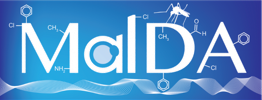Discovery of a Quinoline-4-carboxamide Derivative with a Novel Mechanism of Action, Multistage Antimalarial Activity, and Potent in Vivo Efficacy.
Journal:
Journal of medicinal chemistry, Volume: 59, Issue: 21Abstract:
The antiplasmodial activity, DMPK properties, and efficacy of a series of quinoline-4-carboxamides are described. This series was identified from a phenotypic screen against the blood stage of Plasmodium falciparum (3D7) and displayed moderate potency but with suboptimal physicochemical properties and poor microsomal stability. The screening hit (1, EC = 120 nM) was optimized to lead molecules with low nanomolar in vitro potency. Improvement of the pharmacokinetic profile led to several compounds showing excellent oral efficacy in the P. berghei malaria mouse model with ED values below 1 mg/kg when dosed orally for 4 days. The favorable potency, selectivity, DMPK properties, and efficacy coupled with a novel mechanism of action, inhibition of translation elongation factor 2 (PfEF2), led to progression of 2 (DDD107498) to preclinical development.
